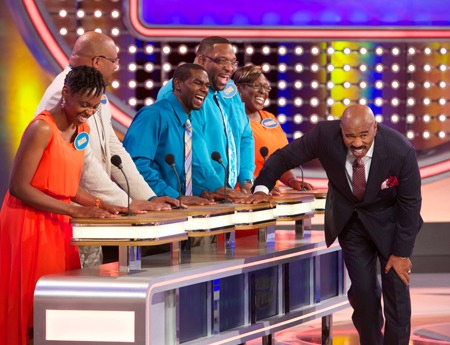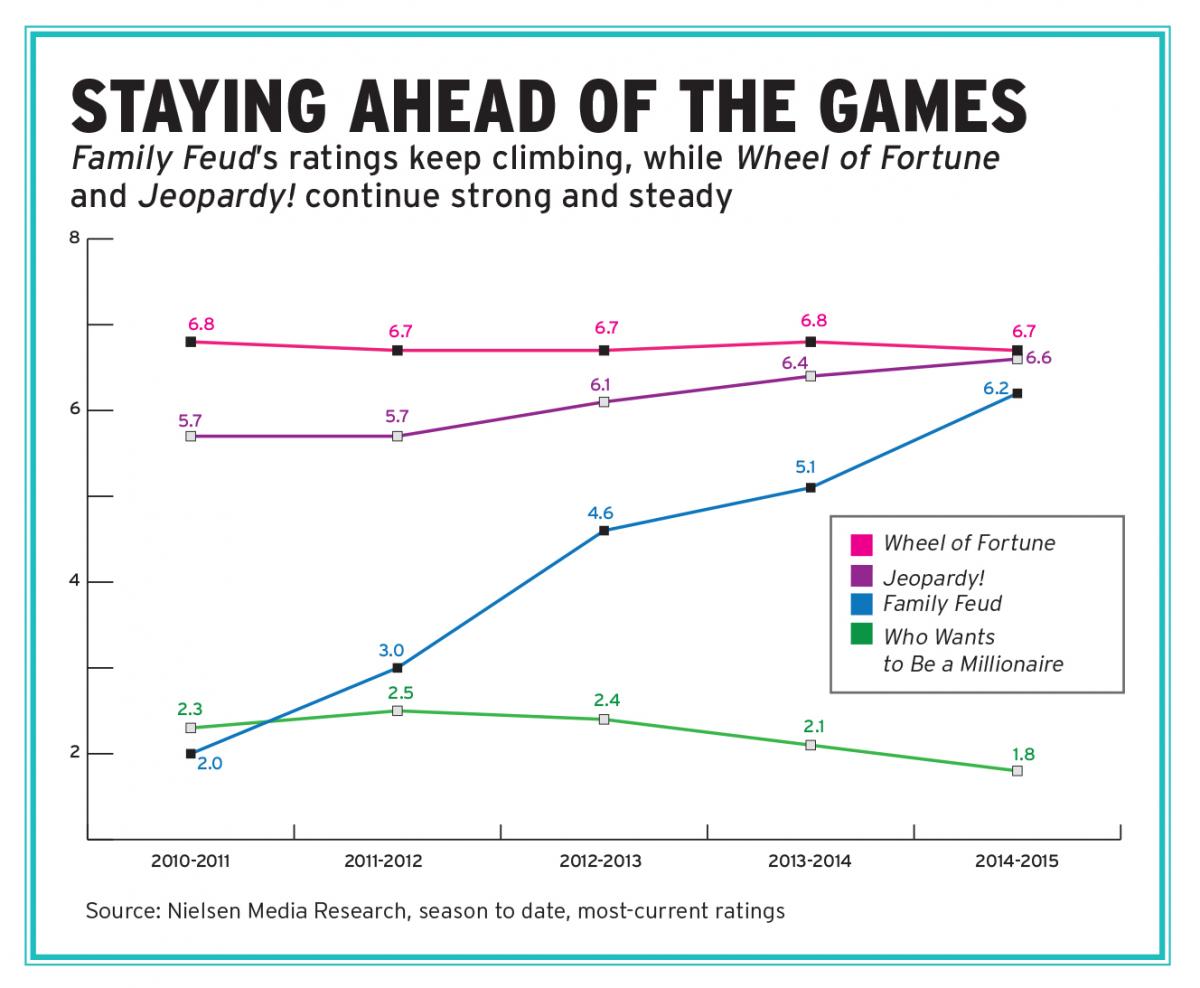'Family Feud' Flying High

Over the summer, Debmar-Mercury’s Family Feud finally did what seemed impossible not so long ago: it overtook CBS Television Distribution’s Wheel of
Fortune and Jeopardy! as syndication’s top game show.
But a look at Family Feud’s trajectory since Steve Harvey took over in 2010 indicates it was only a matter of time before the show overtook the two syndicated classics. When Harvey debuted, Feud averaged a 2.0 in households and a 1.0 among daytime’s key demo of women 25-54, far behind Wheel, Jeopardy! and Disney-ABC’s Who Wants to Be a Millionaire in households but beating Millionaire by a tenth among women 25-54.
Since then, Feud has gained ground every year, jumping to a 3.0 in 2011-12, a 4.6 in 2012-13, a 5.1 in 2013-14 and going over the 6.0 mark last season, finishing 2014-15 at a 6.2, according to Nielsen Media Research. This past summer, Feud frequently led both Wheel and Jeopardy!, something that hasn’t happened in a quarter-century. Season-to-date, Feud is first-run syndication’s No. 2 show among women 25-54 at a 2.9, just one-tenth of a ratings point behind CTD’s Judge Judy.
Feud has several things going for it that have helped the show defy gravity. First and foremost is Harvey himself.
“It was totally Steve Harvey,” says Mort Marcus, copresident of Debmar-Mercury, which distributes Feud; FremantleMedia North America produces it. “The ratings kept going down until he came in. We didn’t spend any money to promote it, it was all word of mouth. As Steve got better and better, videos started to go viral.”
Since then, Fremantle and Feud’s production team, led by executive producer Gaby Johnston, have produced the show to Harvey’s strengths, often letting the cameras roll longer during tapings to catch more of the host’s off-the-cuff comments and reactions. The show also has gotten purposely racier, which has garnered some criticism from online commentators, but ratings have steadily climbed.
Broadcasting & Cable Newsletter
The smarter way to stay on top of broadcasting and cable industry. Sign up below
Once the show’s ratings started showing life, time-period upgrades started rolling in. Early on, Sinclair Broadcast Group upgraded the show in Dayton, Ohio, at the urging of Bill Butler, who was then Sinclair’s head of programming and recently was promoted to senior VP of promotion and corporate marketing.

“It’s really one of those things where momentum begets momentum,” says Ira Bernstein, copresident of Debmar-Mercury. Feud continues to get upgrades in various markets, so ratings should continue to climb.
Two other things work in Feud’s favor. It’s doublerun—sometimes with both episodes airing in access—in many markets across the country. The show also airs multiple times a day on GSN. All of those airings contribute to Feud’s total rating.
Although Feud’s climb is making a lot of noise in a ratings environment where that sort of upward trajectory is rarely seen, CTD’s Wheel of Fortune and Jeopardy! remain strong.
At the close of last season, Wheel was still by far the game-show ratings leader at a 6.7 in households. The Pat Sajak-led show accomplishes that with mostly single runs on ABC owned and affiliated stations in access slots. Jeopardy!, which has more double-runs than Wheel, ended last season very close behind at a 6.6. Feud came in third at a 6.2, although it’s been leading the women 25-54 demo race since the 2013-14 season. Neither Wheel nor Jeopardy! air on cable.
Meanwhile, Disney-ABC’s Who Wants to Be a Millionaire has changed its host three times since Meredith Vieira departed in 2013: Cedric the Entertainer hosted in 2013, Terry Crews last season and this year, The Bachelor’s Chris Harrison is in the hot seat. Unlike Feud, which lends itself more to humor, the changes have not helped Millionaire’s ratings, which have dropped every year since 2011-12, when it averaged a 2.5 in households. Last season, Millionaire finished at a 1.8 and so far this year it’s averaging a 1.2 in households. The show recently was downgraded to late night on WABC New York in order to make room for Disney-ABC’s FABLife.
Debmar-Mercury last fall launched Celebrity Name Game, which is produced by Fremantle Media NorthAmerica and stars Craig Ferguson, and that show is hanging in there at a 1.3 household average. That show started out airing on Tribune-owned stations in late afternoon and access time periods. This year, it’s been downgraded to earlier afternoon slots in many markets, but its ratings are holding and the show seems to be faring better in less-competitive time slots.
Family Feud’s success and the lack of new game shows has encouraged producers to look around for new projects to launch. Debmar-Mercury is developing a show, though Marcus and Bernstein are not talking about what formats they are considering. Sony Pictures Television is said to be looking to bring Chain Reaction off of GSN into syndication. Monopoly Millionaires’ Club, currently a weekly sitcom based on a national lottery game, might evolve into a strip.
Mike Darnell, Warner Bros. president of unscripted and alternative television, has 500 Questions picked up for a second run on ABC in partnership with Mark Burnett. Warner Bros. and Darnell also are debuting Heads Up!, based on the popular app developed by Ellen DeGeneres’ production company and hosted by The Real’s Loni Love, set for HLN early next year.
Both 500 Questions and Heads Up! could potentially enter into broadcast syndication. Many shows—including Millionaire, Twentieth’s Are You Smarter Than a Fifth Grader and NBCUniversal’s Deal or No Deal—began their runs in primetime before giving syndication a shot.
Contributing editor Paige Albiniak has been covering the business of television for more than 25 years. She is a longtime contributor to Next TV, Broadcasting + Cable and Multichannel News. She concurrently serves as editorial director for The Global Entertainment Marketing Academy of Arts & Sciences (G.E.M.A.). She has written for such publications as TVNewsCheck, The New York Post, Variety, CBS Watch and more. Albiniak was B+C’s Los Angeles bureau chief from September 2002 to 2004, and an associate editor covering Congress and lobbying for the magazine in Washington, D.C., from January 1997 - September 2002.

